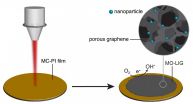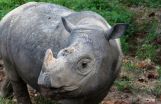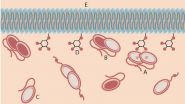(Press-News.org) HOUSTON - (Aug. 20, 2015) - Rice University chemists who developed a unique form of graphene have found a way to embed metallic nanoparticles that turn the material into a useful catalyst for fuel cells and other applications.
Laser-induced graphene, created by the Rice lab of chemist James Tour last year, is a flexible film with a surface of porous graphene made by exposing a common plastic known as polyimide to a commercial laser-scribing beam. The researchers have now found a way to enhance the product with reactive metals.
The research appears this month in the American Chemical Society journal ACS Nano.
With the discovery, the material that the researchers call "metal oxide-laser induced graphene" (MO-LIG) becomes a new candidate to replace expensive metals like platinum in catalytic fuel-cell applications in which oxygen and hydrogen are converted to water and electricity.
"The wonderful thing about this process is that we can use commercial polymers, with simple inexpensive metal salts added," Tour said. "We then subject them to the commercial laser scriber, which generates metal nanoparticles embedded in graphene. So much of the chemistry is done by the laser, which generates graphene in the open air at room temperature.
"These composites, which have less than 1 percent metal, respond as 'super catalysts' for fuel-cell applications. Other methods to do this take far more steps and require expensive metals and expensive carbon precursors."
Initially, the researchers made laser-induced graphene with commercially available polyimide sheets. Later, they infused liquid polyimide with boron to produce laser-induced graphene with a greatly increased capacity to store an electrical charge, which made it an effective supercapacitor.
For the latest iteration, they mixed the liquid and one of three concentrations containing cobalt, iron or molybdenum metal salts. After condensing each mixture into a film, they treated it with an infrared laser and then heated it in argon gas for half an hour at 750 degrees Celsius.
That process produced robust MO-LIGs with metallic, 10-nanometer particles spread evenly through the graphene. Tests showed their ability to catalyze oxygen reduction, an essential chemical reaction in fuel cells. Further doping of the material with sulfur allowed for hydrogen evolution, another catalytic process that converts water into hydrogen, Tour said.
"Remarkably, simple treatment of the graphene-molybdenum oxides with sulfur, which converted the metal oxides to metal sulfides, afforded a hydrogen evolution reaction catalyst, underscoring the broad utility of this approach," he said.
INFORMATION:
Rice graduate student Ruquan Ye and Rice alumnus Zhiwei Peng, now a postdoctoral researcher at the University of Maryland, are lead authors of the paper. Co-authors are Rice graduate students Tuo Wang, Jibo Zhang and Lizanne Nilewski; Rice undergraduate Yunong Xu; and Rice alumnus Jian Lin, an assistant professor of mechanical and aerospace engineering at the University of Missouri. Tour is the T.T. and W.F. Chao Chair in Chemistry as well as a professor of materials science and nanoengineering and of computer science and a member of Rice's Smalley-Curl Institute.
The Air Force Office of Scientific Research and its Multidisciplinary University Research Initiative supported the research.
Read the abstract at http://pubs.acs.org/doi/abs/10.1021/acsnano.5b04138.
This news release can be found online at http://news.rice.edu/2015/08/20/laser-burned-graphene-gains-metallic-powers/
Follow Rice News and Media Relations via Twitter @RiceUNews
Related Materials:
Tour Group: http://www.jmtour.com
Wiess School of Natural Sciences: http://naturalsciences.rice.edu
Images for download:
http://news.rice.edu/wp-content/uploads/2015/08/0824_LIG-1-web.jpg
Rice University chemists have found a way to embed metallic nanoparticles into laser-induced graphene. The particles turn the material into a useful catalyst for fuel cell and other applications. (Credit: Tour Group/Rice University)
http://news.rice.edu/wp-content/uploads/2015/08/0824_LIG-2-web.jpg
Rice University chemists have found a way to embed metallic nanoparticles into laser-induced graphene. The particles turn the material into a useful catalyst for fuel cell and other applications. (Credit: Tour Group/Rice University)
http://news.rice.edu/wp-content/uploads/2015/08/0824_LIG-3-web.jpg
A scanning electron microscope image shows cobalt-infused metal oxide-laser induced graphene produced at Rice University. The material may be a suitable substitute for platinum or other expensive metals as catalysts for fuel cells. The scale bar equals 10 microns. (Credit: Tour Group/Rice University)
http://news.rice.edu/wp-content/uploads/2015/08/0824_LIG-4-web.jpg
A scanning electron microscope image shows cobalt nanoparticles embedded in metal oxide-laser induced graphene produced at Rice University. The material may be a suitable substitute for platinum or other expensive metals as catalysts for fuel cells. The scale bar equals 100 nanometers. (Credit: Tour Group/Rice University)
Located on a 300-acre forested campus in Houston, Rice University is consistently ranked among the nation's top 20 universities by U.S. News & World Report. Rice has highly respected schools of Architecture, Business, Continuing Studies, Engineering, Humanities, Music, Natural Sciences and Social Sciences and is home to the Baker Institute for Public Policy. With 3,888 undergraduates and 2,610 graduate students, Rice's undergraduate student-to-faculty ratio is 6-to-1. Its residential college system builds close-knit communities and lifelong friendships, just one reason why Rice is ranked No. 1 for best quality of life and for lots of race/class interaction by the Princeton Review. Rice is also rated as a best value among private universities by Kiplinger's Personal Finance. To read "What they're saying about Rice," go here.
David Ruth
713-348-6327
david@rice.edu
Mike Williams
713-348-6728
mikewilliams@rice.edu
Leading scientists and experts in the field of rhino conservation state in a new paper that it is safe to consider the Sumatran rhinoceros extinct in the wild in Malaysia. The survival of the Sumatran rhino now depends on the 100 or fewer remaining individuals in the wild in Indonesia and the nine rhinos in captivity.
Despite intensive survey efforts, there have been no signs of the wild Sumatran rhinoceros (Dicerorhinus sumatrensis) in Malaysia since 2007, apart from two females that were captured for breeding purposes in 2011 and 2014. Scientists now consider the species ...
An international team of scientists headed by biologists at UC San Diego has discovered that an important class of stem cells known as human "induced pluripotent stem cells," or iPSCs, which are derived from an individual's own cells, can be differentiated into various types of functional cells with different fates of immune rejection.
The scientists also found that these cells may not be rejected by the immune system if iPSCs are turned into retinal pigment epithelium cells destined for the eye.
Their discovery provides hope for the development of human stem cell therapies ...
A team of Swiss geneticists from the University of Geneva (UNIGE), the École Polytechnique Fédérale de Lausanne (EPFL), and the University of Lausanne (UNIL) discovered that genetic variation has the potential to affect the state of the genome at many, seemingly separated, positions and thus modulate gene activity, much like a conductor directing the performers of a musical ensemble to play in harmony. These unexpected results, published in Cell, reveal the versatility of genome regulation and offer insights into the way it is orchestrated.
Chromatin, a ...
An international group of researchers led by Carnegie Mellon University physicists Mathias Lösche and Frank Heinrich have established the structure of an important tumor suppressing protein, PTEN. Their findings provide new insights into how the protein regulates cell growth and how mutations in the gene that encodes the protein can lead to cancer. The study is published online in Structure, and will appear in the Oct. 6 issue.
Phosphatase and tensin homolog (PTEN) is a known tumor suppressing protein that is encoded by the PTEN gene. When expressed normally, the ...
The hippocampus in the brain's temporal lobe is responsible for more than just long-term memory. Researchers have for the first time demonstrated that it is also involved in quick and successful conflict resolution. The team headed by Prof Dr Nikolai Axmacher from the Ruhr-Universität Bochum (RUB), together with colleagues from the University Hospital of Bonn as well as in Aachen and Birmingham, reported in the journal "Current Biology".
Decision conflicts occur often in everyday life
In their everyday life, people are constantly confronted with decision conflicts, ...
Researchers estimate the 20-year breast cancer-specific death rate for women diagnosed with ductal carcinoma in situ to be 3.3 percent, although the death rate is higher for women diagnosed before age 35 and for black women, according to an article published online by JAMA Oncology.
Ductal carcinoma in situ breast (DCIS) cancer, which is also referred to as stage 0 breast cancer, accounts for about 20 percent of the breast cancers detected through mammography. Some women with DCIS experience a second breast cancer (DCIS or invasive) and a small proportion of patients ...
People with psychopathic characteristics are less likely to be affected by "contagious yawning" than those who are empathetic, according to a Baylor University psychology study.
Yawning after spotting someone else yawn is associated with empathy and bonding, and "catching" yawns happens with many social mammals, among them humans, chimpanzees and dogs, researchers say.
The study -- "Contagious yawning and psychopathy" -- involved 135 college student respondents and was published online in the journal Personality and Individual Differences.
"You may yawn, even if you ...
NEW YORK (August 20, 2015) - No single genetic strain of the widespread Clostridium difficile (C. difficile) bacteria appears to be any more harmful than other strains, according to new research published online today in Infection Control & Hospital Epidemiology, the journal of the Society for Healthcare Epidemiology of America.
The findings contradict previous research suggesting that the emergence of the most severe C. difficile infections (CDI) could be linked with a particular strain known as Ribotype 027 (R027). C. difficile is a highly infectious diarrhea that ...
Bethesda, MD (Aug. 19, 2015) -- Frustrated by a maintenance of certification process that doesn't improve patient care, the American Gastroenterological Association (AGA) this week released a proposed alternate pathway to recertification that is based on established learning theory. 1,3 It eliminates the high-stakes examination and replaces it with active, adaptive, self-directed learning modules that allow for continuous feedback.
AGA shared the proposed pathway with the American Board of Internal Medicine (ABIM), which runs the current maintenance of certification ...
Working parents often worry about sending their toddlers to daycare. But the results of a new study that tracked almost 1,000 Norwegian children enrolled in daycare indicate that working parents can breathe a sigh of relief: The amount of time children spent in daycare had little impact on aggressive behavior.
The study is published in Psychological Science, a journal of the Association for Psychological Science.
"From a public perspective, our findings are important because they should help ease parents' fears about the potential harms of early non-parental child care," ...




